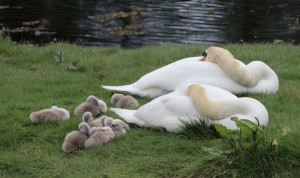 Despite the weather in the latter part of August, the year 2014 will surely go down as a very successful year for many breeding birds. You only have to look in gardens to realise that several birds not only brought off one brood but in many cases even managed a second brood before the weather changed. With some birds it is difficult to tell the difference between the first and second broods. This is particularly the case with blackbirds as the plumage varies so much. With robins it is easier as, for example, the birds from the first brood are now moulting their feathers so that the final red breast feather are just showing through. With robins from the second brood the spotted breast feathers are still dominant.
Despite the weather in the latter part of August, the year 2014 will surely go down as a very successful year for many breeding birds. You only have to look in gardens to realise that several birds not only brought off one brood but in many cases even managed a second brood before the weather changed. With some birds it is difficult to tell the difference between the first and second broods. This is particularly the case with blackbirds as the plumage varies so much. With robins it is easier as, for example, the birds from the first brood are now moulting their feathers so that the final red breast feather are just showing through. With robins from the second brood the spotted breast feathers are still dominant.
Another very successful bird this year, and one that often breeds in gardens, is the house sparrow. For the last few years their numbers have decreased and nobody really knows why but this year there seems to be more “spadges” around than for many years. The majority of these have indeed brought off two broods this year and have been assembling in increasing flocks since the first brood came off. House sparrows nest in holes in trees and increasingly in artificial nestboxes. Three years ago there was even a specially designed nest box for them taking advantage of the fact they are loose colonial birds. This means they nest is groups although each nest may not necessarily be adjacent to the next. If the numbers get too many they will start nesting in loose groups in bushes. There the nests looks as if a grassy spadefull of turf has been thrown into a hedge or shrub.
If you look at feeders such as those with peanuts then you will see just how many young blue tits and great tits are at them. Both these small birds only bring off one brood each year and perhaps this is because they may have to rear so many young as the number of eggs they lay is up to twelve with both birds. With all the birds mentioned so far, once the birds have left the nest they can fly and they need to develop rapidly. The reason is that in most cases they will breed the following year so it is essential they are in good condition. Other birds, mainly the ground nesting birds, cannot fly until some time after they have left the nest. A good example is the pheasant that will not fledge until much later in the year. This puts them at a disadvantage as they are often predated by such birds as gulls and carrion/hooded crows and mammals such as stoats and foxes.
In the wider countryside there are much larger birds that take a few years before they will be mature enough to breed. One very large one that breeds around Inverness is the mute swan. I took the photograph on the banks of the River Nairn in the seaward side of Nairn. Whilst the cuddly looking cygnets will fly later this year it will be a number of years ( three or four ) before they have developed that all white plumage which means they are ready to breed. Despite being such a large bird they still have their problems. Discarded fishing lines with lead weights have caused many deaths as have lead shot on the ground from shooting. Overhead cables also are a problem in some areas but at least mute swans are no longer prized as a delicacy at banquets!
Tags: highland wildlife
